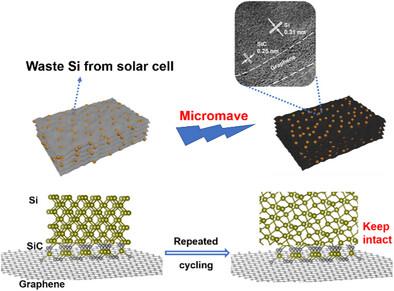通过微波辐照还原增强界面相互作用,回收光伏废硅用于锂存储
IF 13
2区 材料科学
Q1 CHEMISTRY, MULTIDISCIPLINARY
引用次数: 0
摘要
微纳级光伏废硅(wSi)作为锂离子电池负极材料具有重要的应用潜力;然而,它面临着一系列与硅在循环过程中体积膨胀有关的挑战。本研究提出了一种简单、高效、环保的微波方法,在短短几秒钟内快速制备石墨烯包被硅材料(wSi@rGO),其中石墨烯作为稳定的界面,减轻了体积膨胀引起的结构破坏,增强了电子和离子的电导率,抑制了硅与电解质之间的不良副反应,促进了固体电解质界面(SEI)的稳定性。重要的是,微波产生的瞬时高温促进了界面SiC化学键的形成,从而加强了Si和石墨烯之间的相互作用,从而减少了Si的分层。wSi@rGO阳极表现出显著的循环稳定性,在250次循环中保持1100ma h g - 1的比容量。此外,组装的wSi@rGO//LiFePO4全电池表现出强大的性能,在0.5 c下循环80次后保持150 mA h g - 1的稳定容量。该研究不仅展示了一种简单有效的微波合成wSi@rGO负极材料的技术,而且为光伏废硅的回收提供了一种环保和经济的途径,对碳峰值和碳中和有积极的贡献。本文章由计算机程序翻译,如有差异,请以英文原文为准。

Enhancing Interfacial Interactions Through Microwave-Irradiated Reduction for the Recycling of Photovoltaic Silicon Waste for Lithium Storage
The application of micro-nano size photovoltaic waste silicon (wSi) as an anode material for lithium-ion battery holds significant practical potential; However, it faces a series of challenges related to the volume expansion of Si during cycling. In this study, a simple, efficient, and eco-friendly microwave method is proposed for the rapid preparation of graphene-coated silicon materials (wSi@rGO) in just a few seconds, in which graphene as the stable interface mitigates structural failure caused by significant volume expansion, enhances electron and ion conductivity, inhibits undesirable side reactions between silicon and electrolyte, and promotes the stability of solid electrolyte interface (SEI). Importantly, the instantaneous high temperature generated by microwaves facilitates the formation of interfacial SiC chemical bonds, which strengthen the interaction between Si and graphene, thereby reducing Si delamination. The wSi@rGO anode exhibits remarkable cycling stability, maintaining a specific capacity of 1100 mA h g−1 over 250 cycles. Furthermore, the assembled wSi@rGO//LiFePO4 full battery demonstrates robust performance, retaining a stable capacity of 150 mA h g−1 after 80 cycles at 0.5 C. This research not only demonstrates a straightforward and efficient microwave technique for synthesizing wSi@rGO anode materials, but also offers an environmentally friendly and economical pathway for recycling photovoltaic waste silicon, contributing positively to carbon peaking and carbon neutrality.
求助全文
通过发布文献求助,成功后即可免费获取论文全文。
去求助
来源期刊

Small
工程技术-材料科学:综合
CiteScore
17.70
自引率
3.80%
发文量
1830
审稿时长
2.1 months
期刊介绍:
Small serves as an exceptional platform for both experimental and theoretical studies in fundamental and applied interdisciplinary research at the nano- and microscale. The journal offers a compelling mix of peer-reviewed Research Articles, Reviews, Perspectives, and Comments.
With a remarkable 2022 Journal Impact Factor of 13.3 (Journal Citation Reports from Clarivate Analytics, 2023), Small remains among the top multidisciplinary journals, covering a wide range of topics at the interface of materials science, chemistry, physics, engineering, medicine, and biology.
Small's readership includes biochemists, biologists, biomedical scientists, chemists, engineers, information technologists, materials scientists, physicists, and theoreticians alike.
 求助内容:
求助内容: 应助结果提醒方式:
应助结果提醒方式:


